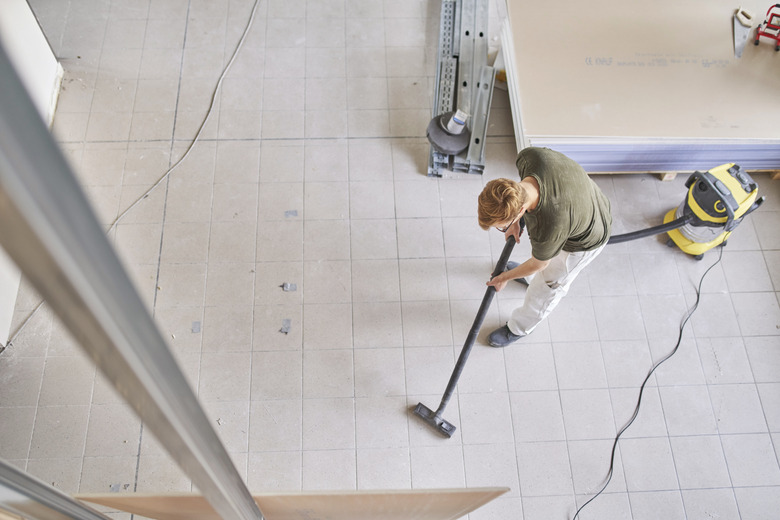How To Clean Sheetrock Dust From The Floor
We may receive a commission on purchases made from links.
Whether you're doing a small drywall repair or drywalling an entire room, there will be dust and plenty of it. A certain amount is produced when you're cutting Sheetrock (drywall), but the bulk of it comes from sanding. You can't avoid it even if you use a power sander with a vacuum extraction system.
The dust isn't toxic, but it's an irritant, so you should wear a dust mask while you're working and it's flying around the room. It's mostly gypsum, mica, and clay, and all these components are water soluble, so you can usually wipe away small deposits with a damp cloth. However, if you have a roomful of dust, you'll want to get rid of most of it before you get any of it wet, or you'll be pushing around a slurry that can get into cracks and pores in your floor and harden there.
Start by Sweeping the Floor
Start by Sweeping the Floor
If you've come to the end of a large drywalling project, there will probably be piles of dust on the floor, so the first thing to do is sweep up as much as you can. Wear a dust mask when doing this and keep a window open to allow stray dust to go outside.
Sweeping is most effective with a soft-bristle push broom. A stiff broom will grind dust into the floor rather than sweeping it away. If you don't have a push broom, go ahead and use a straight or angled broom but be aware that the back and forth sweeping action will raise more dust than the straight-ahead motion of a push broom.
Whichever type you choose, use a light touch, move as much dust as you can into a pile, collect it with a dust pan, and discard it in the trash. It isn't toxic, so you don't have to worry about disposing of it as hazardous waste.
Next, Vacuum the Floor
Next, Vacuum the Floor
After you've removed the bulk of the dust by sweeping, it's time to break out the vacuum cleaner. Vacuuming with a wide attachment is the best way to clean up drywall dust on a concrete floor, and it also works well for wood and vinyl floors.
If you're cleaning dust off a hardwood floor, you'll need to have a crevice attachment handy for extracting dust from between the floorboards. Do a general cleanup of the floor and then come back with the crevice tool and suck dust from the gaps. This is also a good time to vacuum dust from windowsills and other flat surfaces on which the dust has settled.
It's important for the dust to be dry while you're vacuuming, or the vacuum won't be able to suck it up. If you have to clean up patches of drywall mud that fell on the floor, let them dry, scrape each one with a paint scraper, and suck it up with the vacuum. This is far easier than trying to clean the patches while the mud is wet.
Finish by Mopping the Floor
Finish by Mopping the Floor
After you're finished vacuuming, the bulk of the dust should be gone, but white streaks will still remain. You can remove these with a damp mop.
If you're cleaning a concrete or vinyl floor, you can use a wet mop, but if you're cleaning a hardwood floor, the mop should only be damp. Hardwood floors can be damaged by moisture, so after mopping drywall dust off one, it's a good idea to go back over the floor with a dry towel to remove excess moisture.
You may have to use a rag to get into corners that the mop can't reach, and if so, have a bucket handy so you can rinse it off frequently. Remember to wring out the rag well if you're cleaning a hardwood floor because moisture can seep into gaps around the edge of the floor. It may take more than one pass with the mop and rag to get all the dust.
